


WASHINGTON’S MOUNTVERNON.ORG H WINTER 2022
PAGE 30
PAGE 24 ARCHIVE THE
PAGE 44
TEACHING
IN SENEGAL PAGE 38 A statue of George Washington—in England, no less—at London’s Trafalgar Square Template of a leader, Washington inspired legions of fans around the globe PAGE 16
GEORGE
OF THE WORLD IN THE EYES RESTORATION THE LAFAYETTE ROOM, UNVEILED
SCHOLARSHIP THE LIFE AND TIMES OF HARRY WASHINGTON
1951 VISIT OF A QUEEN-TO-BE
EDUCATION
GEORGE WASHINGTON
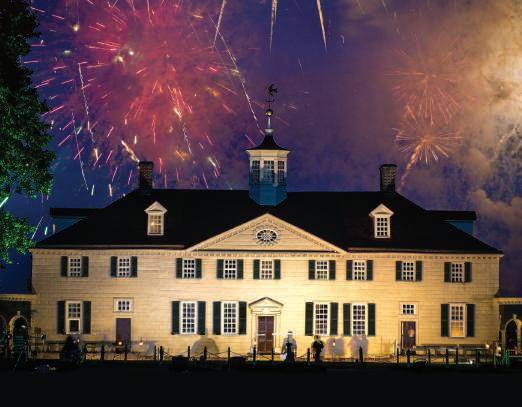
CHRISTMAS ILLUMINATIONS
Enjoy an enchanted evening of celebratory fireworks, wintry lights, and holiday music, December 16–17.

MOUNT VERNON BY CANDLELIGHT
Take a guided tour of our lantern-lit historical area and meet people from Washington’s world.
Select dates, November 25–December 18.
mountvernon.org/christmas

CONSULTING EDITOR:
Norie Quintos
DESIGNER: Jerry Sealy
PRODUCTION MANAGER: Matt Briney
VISUAL RESOURCES: Dawn Bonner
CONTRIBUTING WRITERS:
Julie Almacy
Matt Briney
Kevin Butterfield
Adam Erby
Amanda Isaac
Margaret Loftus
Jessie MacLeod
Dean Norton
Kristen Otto
Dana Stefanelli
Melanie Welles
CONTRIBUTING PHOTOGRAPHERS:
Dan Chung
Brandon Hull
Zerah Jakub
Sierra Medellin
Norie Quintos
Clarissa Villondo
Mount Vernon magazine is published three times a year by the Mount Vernon Ladies’ Association, the nonprofit organization that owns and manages George Washington’s estate. We envision an America where all know and value the singular story of the father of our country. Ever mindful of our past, we seek innovative and compelling ways to tell the story of George Washington, so that his timeless and relevant life lessons are accessible to the world.
This publication is produced solely for nonprofit, educational purposes, and every reasonable effort is made to provide accurate and appropriate attribution for all elements, including historical images in the public domain. All written material, unless otherwise stated, is the copyright of the Mount Vernon Ladies’ Association. While vetted for accuracy, the feature articles included in this magazine reflect the research and interpretation of the contributing authors and historians.
George Washington’s Mount Vernon
P.O. Box 110, Mount Vernon, Virginia 22121
All editorial, reprint, or circulation correspondence should be directed to magazine@mountvernon.org.
mountvernon.org/magazine
ABOUT THE COVER
A bronze statue of George Washington stands in Trafalgar Square, in the heart of London, presented to the British by the Commonwealth of Virginia in 1921. It is one of some 25 replicas cast of a 1788 marble statue by the sculptor Jean-Antoine Houdon. Because legend had it that Washington once swore he would never again set foot on British soil, the statue was laid on a foundation of Virginia soil. Photo: Wikimedia Commons

GEORGE WASHINGTON’S MOUNTVERNON.ORG H WINTER 2022
JOIN US FOR THESE POPULAR EVENTS
MARK YOUR CALENDAR!
UPCOMING AT MOUNT VERNON

GLOBAL A FFAIRS IN THE AGE OF WASHINGTON
16 | In the Eyes of the World
In exhibiting a new model of leadership, George Washington sparked—and still enjoys—a worldwide fandom
Plus: Washington monuments around the globe
By Craig Bruce Smith
24 | Travels With Harry Washington
Like his enslaver, he fought against oppression, but did so by joining—rather than opposing—the British
By Joseph J. Ellis
30 | A Noble Room
The Marquis de Lafayette’s bedroom returns to its former glory
By Amanda Isaac
GEORGE WASHINGTON’S MOUNT VERNON 1
Washington commisioned this portrait of the Marquis de Lafayette. A reproduction hangs in the restored Lafayette Room. See story, page 30.
FEATURES
PORTRAIT OF MARQUIS DE LAFAYETTE, CHARLES WILLSON PEALE, CIRCA 1779, MUSEUMS AT WASHINGTON AND LEE UNIVERSITY
4 | News
Washington’s coat at the Met, inside the “Lives, Loves, Loss” program, VIP visit, spring cleaning, and more
12 | Object Spotlight
A meticulously painted and embroidered map of Washington, D.C., by a teenage girl in 1802
14 | Focus on Philanthropy
Monika and Tim Stoy’s giving is inspired in part by Monika’s immigrant parents
38 | Washington in the Classroom
In Dakar, Senegal, George Washington’s legacy resonates beyond U.S. borders
40 | Shows of Support
Events at Mount Vernon, and in Newport, Rhode Island
44 | Featured Photo
A royal welcome for the British princess who would become Queen Elizabeth II

George Washington’s Mount Vernon estate is owned and maintained in trust for the people of the United States by the Mount Vernon Ladies’ Association of the Union, a private, nonprofit 501(c)(3) organization founded in 1853 by Ann Pamela Cunningham.
MOUNT VERNON LADIES’ ASSOCIATION
Margaret Hartman Nichols, Regent
Andrea Notman Sahin, Secretary
Anne Neal Petri, Treasurer
VICE REGENTS
Cameron Kock Mayer, Louisiana
Maribeth Armstrong Borthwick, California
Ann Haunschild Bookout, Texas
Jean Armfield Sherrill, North Carolina
Virginia Dawson Lane, South Carolina
Laura Peebles Rutherford, Alabama
Susan Marshall Townsend, Delaware
Anne Neal Petri, Wisconsin
Liz Rollins Mauran, Rhode Island
Ann Cady Scott, Missouri
Sarah Miller Coulson, Pennsylvania
Susan Stevens Reeder, Mississippi
Andrea Notman Sahin, Massachusetts
Catherine Hamilton Mayton, Arkansas
Helen Herboth Laughery, Wyoming
Catherine Marlette Waddell, Illinois
Lucia Bosqui Henderson, Virginia
Mary Lang Bishop, Oregon
Elizabeth Medlin Hale, Georgia
Ann Sherrill Pyne, New York
Karen McCabe Kirby, New Jersey
Hilary Carter West, District of Columbia
Adrian MacLean Jay, Tennessee
SENIOR STAFF
Douglas Bradburn, President & CEO
Kevin Butterfield, Executive Director, Washington Library
Joe Bondi, Senior Vice President, Development
Matt Briney, Vice President, Media & Communications
Phil Manno, Chief Financial Officer
Susan P. Schoelwer, Executive Director, Historic Preservation
& Collections & Robert H. Smith Senior Curator
Joseph Sliger, Vice President, Operations & Maintenance
K. Allison Wickens, Vice President, Education
WINTER 2022 | MOUNT VERNON LADIES’ ASSOCIATION 2
DEPARTMENTS
One of my favorite items in the collection at Mount Vernon is the globe George Washington ordered when he became president of the United States. As the leader of a new nation hoping to make its way as a world power, Washington needed an accurate depiction of the world that would inevitably shape the affairs of the day. The globe, expertly crafted in London by the king’s official globe maker, Dudley Adams, is an exquisite snapshot of the world at that moment in time. (Within a decade, the political borders of Washington’s globe would be obsolete.) After Washington’s second term, the globe returned with its owner to Mount Vernon. Acquired by the Mount Vernon Ladies’ Association in 1860, it has been here ever since, a constant reminder that Mount Vernon and George Washington are an important part of a global story.
As we will see in this innovative and timely issue of Mount Vernon, this small corner of Virginia, however provincial, was always connected to a wider world. From the food, fashions, and items in everyday use, the experience of Mount Vernon cannot be understood by approaching it as an isolated or “self-sufficient” plantation. Add in the unique story of George Washington, whose international fame began in his early 20s, and who would eventually become one of the most well-known people in history, and the global connections of this place are far-reaching and ongoing.
When we think about what is exceptional about the United States, we can proudly claim the “father of our country” as a figure studied and revered the world over, wherever democracies struggle to find trustworthy leadership. The recent reopening of the Lafayette bedchamber, which you can read about in a piece by associate curator Amanda Isaac, again reminds us of the powerful connection between American and French revolutionary beginnings. But Washington’s example has been an even broader inspiration. Statues honoring him have been erected all over the world, from Bogotá to Mexico City to Budapest, and even London’s Trafalgar Square. In this issue, Craig Bruce Smith examines how the world admired Washington during his time and
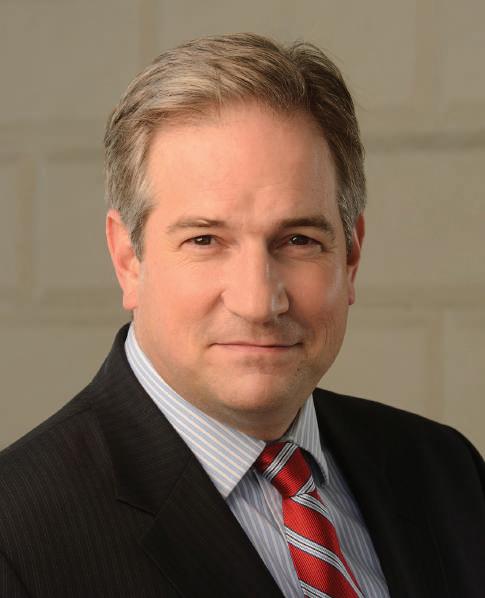
how leaders through time have used—and misused—his revolutionary example.
Other global stories connected to Mount Vernon inevitably involve the enslaved labor on which the Washingtons relied. Indeed, Mount Vernon was home to a number of people who had been born in Africa. One such story involves a little-known enslaved groom, Harry Washington, who as Pulitzer Prize–winning historian Joseph Ellis shows, had an extraordinary life, an epic tale of courage and revolution mirroring George Washington’s own pursuit of liberty.
I know you will enjoy this eclectic look at a few of Mount Vernon’s many global connections. And I hope to see you back here soon, as the world turns.
 Douglas Bradburn President and CEO
Douglas Bradburn President and CEO
GEORGE WASHINGTON’S MOUNT VERNON 3
From the President
Fashion Statement at the Met
George Washington’s coat featured at exhibit on American fashion
George Washington never made it to New York’s Metropolitan Museum of Art (it didn’t exist yet), but his brown wool presidential coat did. Associate curator Amanda Isaac traveled to Manhattan to oversee its installation in the exhibition In America: An Anthology of Fashion, organized by the Costume Institute and the American Wing, which ran from May 7 to September 5.
The single-breasted American-made coat (circa 1789) is the lead object in the show, the first fashion statement guests encounter upon entering the American period rooms. According to an article in Vogue, “What the exhibition does throughout 13 period rooms is exalt the unsung heroes…. [It] chronicles the anonymous hands, hearts, and minds that shaped the look and feel of what today would be called quintessentially American style.”
Recent conservation by consulting textile conservators Deirdre Windsor and Johanna Tower made it possible for the coat to be displayed publicly for the first time since the 1930s, using an innovative mount they designed to visually conjure Washington’s form and showcase the suit’s elegant cut.

4 WINTER 2022 | MOUNT VERNON LADIES’ ASSOCIATION Mount Vernon News
SEE AND LEARN MORE ABOUT THE COAT AT MOUNTVERNON.ORG/WASHINGTONCOAT
METROPOLITAN MUSEUM OF ART
THE
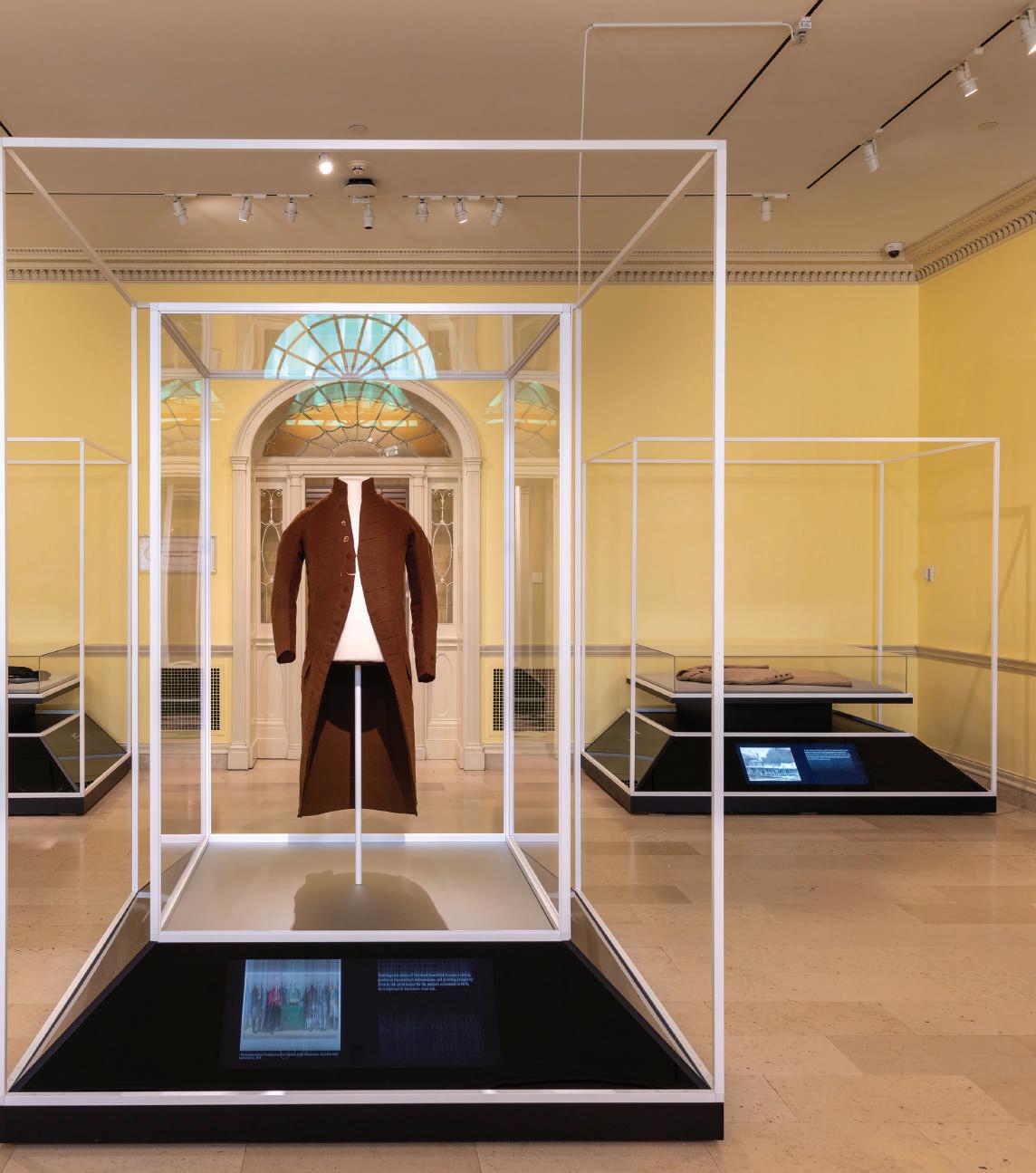
GEORGE WASHINGTON’S MOUNT VERNON 5
Style icon: The coat Washington likely wore to his inauguration takes center stage at the Met.

Of Lives, Loves, and Loss
Inside a moving and popular Mount Vernon family program
On May 21, Mount Vernon invited guests to join them for a day of remembrance of those enslaved at Mount Vernon. Lives, Loves, and Loss follows several families: that of Boatswain, a ditcher, and his wife Myrtilla; Hercules, Washington’s enslaved cook, and his wife Alice; and others.
Senior interpretive supervisor Anette Ahrens and manager of history interpretation Kathleen Ford each led a 10-stop tour through the places and spaces in which these families worked and lived.
After hearing the stories and walking in their footsteps, participants contributed to a memory book and decorated stones. The program culminated with a brief commemorative ceremony at the African American burial ground, led by Tramia Jackson, Mount Vernon’s director of learning, and ZSun-nee Matema, a member of the League of Descendants of the Enslaved at Mount Vernon, along with Madeline Tinsley, community programs intern. Participants placed the stones they had decorated at the grave sites.
This program is offered in various formats several times a year.

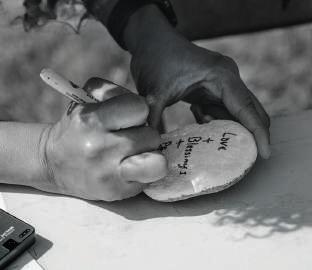
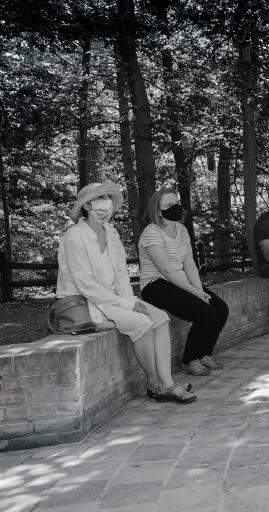
6 WINTER 2022 | MOUNT VERNON LADIES’ ASSOCIATION Mount Vernon News
PHOTOS: MVLA
Clockwise from above: Participants of the Lives, Loves, and Loss program decorate stones, lay them on grave sites at the burial ground, and listen to the stories of a character interpreter.

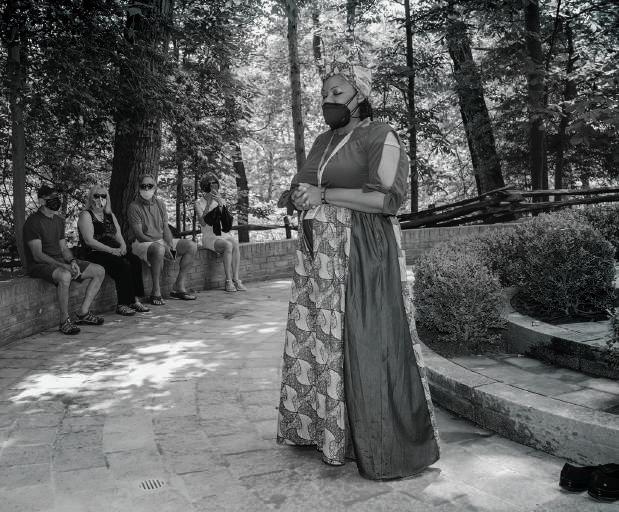

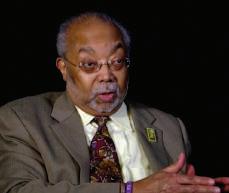


Gathering the Stories
Recording of oral histories continues
Mount Vernon’s digital historian, Jim Ambuske, assisted the League of the Descendants of the Enslaved at Mount Vernon Oral History Project in recording two additional oral histories this month. Thirteen oral histories have been recorded to date. While Mount Vernon has one of the best records of the enslaved individuals on an 18th-century plantation—a result of Washington’s request for weekly reports while away during the war and his presidency—there are many details not recorded in these logs, such as family traditions, the enslaved workers’ impressions of the Washingtons and their guests, and the challenges of daily life. Oral histories, passed down from generation to generation, allow historians to develop a more complete picture of those enslaved at Mount Vernon. “We helped build this place and make it what it is,” notes Shawn Costly, a descendant of Davy and Edy Jones. “We helped make the president who he was.” To learn more about the League of the Descendants, visit its Facebook group at mountvernon.org/league. And to view a video excerpt of the oral histories, visit mountvernon.org/oralhistory.
GEORGE WASHINGTON’S MOUNT VERNON 7
Among descendants who have recorded oral histories are (clockwise from upper left) ZSun-nee Matema, Rohulamin Quander, Ann Chinn, and Shawn Costly.
Garden of Ideas
Inside the 2022 Mount Vernon Symposium
In early June, the Washington Library hosted the threeday annual Mount Vernon Symposium, which examined a wide variety of topics related to gardens and landscapes. “Under my Vine & Fig Tree”: Gardens and Landscapes in the Age of Washington and Now featured a lineup of 14 speakers, including four from England and one from France. Presentations included the keynote address by the renowned Virginia landscape architect Thomas Woltz, on bridging past and future in historic landscapes; British landscapes authorities John Phibbs on picturesque landscapes by Capability Brown, and Todd Longstaffe-Gowan on the restoration of gardens at Hampton Court Palace; Michael Dirr’s hit parade of noble trees; and art historian Carrie Rebora


A
Barratt on the connections between art and nature in historic houses, gardens, and museums.
The event attracted 130 in-person subscribers, and included, for the first time, virtual symposium tickets, with 227 paying attendees.
In addition to gourmet meals and intimate receptions, the symposium
Field School
Fincluded an emerging scholars panel discussion, Mansion tours, and an alfresco dinner on Saturday evening in George Washington’s upper garden.
The Mount Vernon Symposium is endowed by the generous support of the Robert H. Smith Family Foundation and Lucy S. Rhame.
ive undergraduates and a graduate student from George Washington University in Washington, D.C., participated in the 2022 Summer Archaeology Field School. Working alongside Mount Vernon’s professionals for six weeks, the students learned the techniques of historical archaeology while conducting geophysical surveys and excavations in the historic area, often under hot and humid conditions. Via readings, discussions, and field trips, students delved into three prominent themes of historic house museums—the evolution of the plantation landscape, African American history, and public interpretation.
8 WINTER 2022 | MOUNT VERNON LADIES’ ASSOCIATION
News
Mount Vernon
GARDEN: MVLA. FRAGMENT: SIERRA MEDELLIN
formal boxwood parterre with a fleur-de-lis pattern, in Mount Vernon’s upper garden.
Found: 18th-century tobacco pipe fragment.
Preventing the Pox
Character program highlights how Washington handled the health of his troops against any disease.
May 1 at Mount Vernon saw the second day of Revolutionary War Weekend and the character program “Unseen Enemy,” about the dangers of smallpox during the Revolutionary War. Portrayed by Dan Shippey, “George Washington” stepped out of his war tent to greet the gathered guests and talk with his friend “Dr. Craik,” portrayed by Tom Plott, manager of character interpretation, about the steps taken to protect soldiers from smallpox. James Craik was the physician general of the U.S. Army, as well as George Washington’s personal physician. He studied at the University of Edinburgh, the top medical school in the world at the time. The following are edited excerpts of what the doctor had to say. (Note these are not direct quotations from the real Dr. Craik, but rather character interpretations based on historical evidence.)
This past July marked the publication of The Papers of Martha Washington, a multiyear project edited by the Papers of George Washington. Published by the University of Virginia Press, this 736-page volume contains transcribed and annotated correspondence gathered from those to whom Martha wrote. Her letters paint a picture of social life during the Revolutionary War and the early republic and also include more than 50 condolence letters after her husband’s death from key Federalist figures in the early 19th century.
firsthand that this could be a very dangerous thing. When he was a young man of 19 or so, he traveled to the island of Barbados and contracted smallpox.
“He survived, though the disease took a toll. It was likely the reason he never fathered children, and he carried the pox marks on his face for the rest of his life.
“Washington knew that if smallpox were allowed to reach the camps, it would blow through there like wind through a lace curtain. So he made what I believe to be the greatest strategic move of the Revolutionary War. He insisted that each and every soldier in the Continental Army be inoculated against the pox. This was the first standing army to be inoculated
Before she died, it is believed, Martha Washington purposefully burned the letters from her husband to keep their relationship private. Two letters from Washington to his wife, however, were found in a desk Martha gave one of her granddaughters. Both date from the early months of the Revolutionary War, in June 1775.
Dr. Craik: “Medically speaking, the biggest challenge during wartime is not gunfire or injury of any sort. It is disease. Early in the war, there was an epidemic of smallpox sweeping the land. George Washington knew
This latest volume contains more than 80 new letters to or from Martha Washington, including four never before published between Martha and her niece Fanny Bassett Washington Lear. The publication also contains one of the most detailed family trees of the Dandridge, Custis, and Washington families, along with a biographical directory of significant people in the volume.
This new volume will be available at the Washington Library for researchers and scholars looking to discover more about Martha Washington’s life. The volume is also available for purchase from the Shops at Mount Vernon.
“[Inoculation consisted of] finding a man who is on the mend. You then take a scarificator, which is a multi-bladed device with springloaded blades. You cup the blades, place them against the pox, and slash the pox. You then lay linen thread in and draw the matter out of that pox. Then go to the person you wish to inoculate, slash their arm, lay in the linen thread, and bind it up. Once it is healed, you draw the threads out. [Because it is a weakened virus, the inoculated person usually only experienced mild symptoms.]
“George Washington believed so greatly in this inoculation that he insisted his family, servants, and the enslaved people at Mount Vernon all be inoculated against the pox also.”
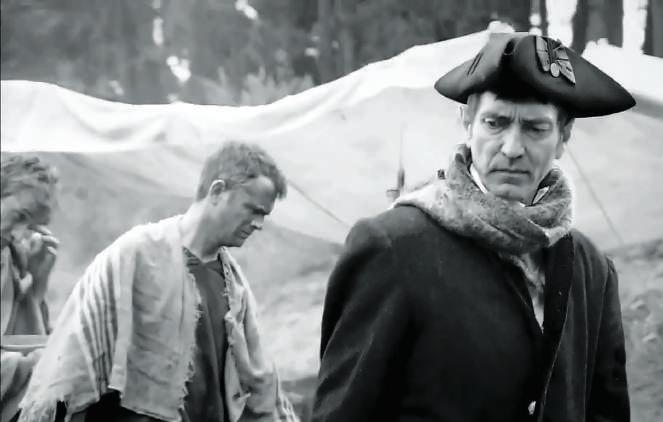
GEORGE WASHINGTON’S MOUNT VERNON 9
9 COURTESY OF
A screenshot from a History Channel documentary on Washington and smallpox.
HISTORY CHANNEL
WATCH A CLIP OF GEORGE WASHINGTON’S LEADERSHIP REGARDING SMALLPOX AT MOUNTVERNON.ORG/SMALLPOX

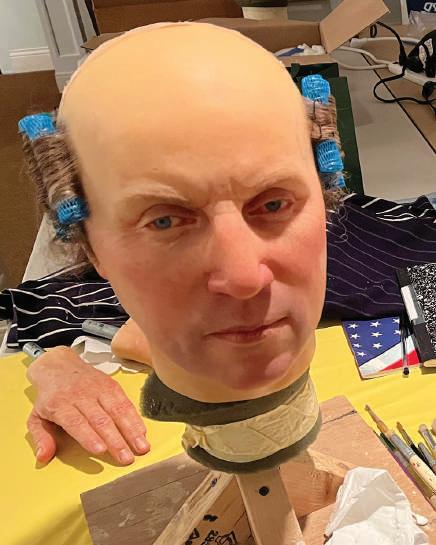
Wash and Style
Shampoos and facials for George Washington and other wax figures
Last April, Sue Day and Steven Horak, Mount Vernon’s forensic figure contractors, returned for the first time since September 2019 to care for the heads and hands of three wax George Washingtons on display, the fiberglass figures of Robert Livingston and Samuel Otis, and the wax heads and hands in the traveling exhibit. The team had some early
mornings and late nights, as the work was done outside public operating hours. Senior manager of education operations Zerah Jakub worked with Day and Horak on a cleaning schedule, as she began the process of cleaning the inauguration, entrepreneur, and surveyor exhibits.
The cleaning team washed wax heads and hands to remove built-up dust, re-painted worn areas, and added detail to skin tones. They washed, restyled, and added new bows to the head hair and wigs for each figure. At the end of the five-day process, Washington was back to his dapper self.

10 WINTER 2022 | MOUNT VERNON LADIES’ ASSOCIATION Mount Vernon News
CHECK OUT THE THREE WAX GEORGE WASHINGTONS ON DISPLAY IN
THE EDUCATION CENTER.
PHOTOS BY ZERAH JAKUB
Spa treatment: In these photos, Sue Day and Steve Horak work on a Washington head.
Notebook
VIP visit: On June 29, former German chancellor Angela Merkel visited Mount Vernon on a private tour. She spent time at the Washington Library, paid her respects at George Washington’s tomb, and signed the Mount Vernon guestbook. Protective sunscreen: Custom-designed ultraviolet light screens were mounted non-invasively to the interior window frames of the Washington bedchamber and study to reduce the amount of UV light entering the spaces. More of these inconspicuous interior screens will be installed throughout the house, replacing exterior UV film that may pose long-term risks to 18th-century glass panes. Green agenda: Nearly 200 Southern Garden History Society members visited Mount Vernon as part of the group’s annual meeting. Topics addressed included Thomas Jefferson’s passion for gardening, the archaeological exploration of John Custis’s garden at Williamsburg, and Japanese plant introductions to the U.S. in the 19th century. Late afternoon rides in a hot air balloon over a 12-acre field offered attendees an unforgettable view of the estate.
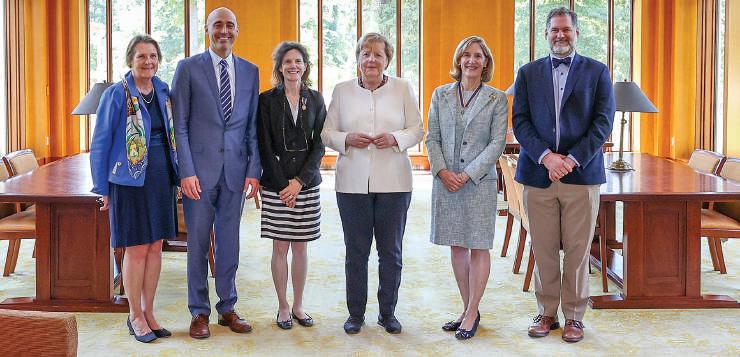
BY THE NUMBERS
4,000 Number of artifacts washed in the archaeology lab in April, ranging from Native American projectile points to camera flashbulbs from the 1980s.


20 Number of bags filled with trash and recyclables during the 34th annual Potomac River Watershed Cleanup, with more than 40 volunteers working.


45
Approximate number of sheep sheared by the livestock team, assisted by Emily Chamelin of Chamelin-Hickman Shearing. The flock was shorn before the arrival of summer.

LEAF THEM BE
Those looking for an excuse to avoid the chore of raking leaves need look no further. Since 2021, Mount Vernon’s horticulture team has let fallen leaves remain in many areas of the estate. “Why purchase bagged mulch when leaving the natural fallen leaf cover is a perfect mulch?” explains Dean Norton, Mount Vernon’s director of horticulture. “It helps retain moisture, can help eliminate freeze damage to plants by acting as a ground insulator, is a weed suppressor, and is free.”
In some “higher visual priority” areas of the estate, gardeners use arborist chips. Both leaves and wood chips are superior to bagged mulch, which is uniform in shape and size and provides little benefit to the soil. In contrast, leaves and chips vary in size and decomposition rate. Over a short period of time, these natural mulches develop a diverse, healthy soil environment.
Historical documents from Washington’s time don’t specifically say whether fallen leaves were left or cleared away, though the head gardener often wrote about “cleaning” within the garden enclosures, and one record on December 3, 1797, noted the “hauling of leaves from the shrubberies.”
LEARN MORE AT MOUNTVERNON.ORG/LANDSCAPES
GEORGE WASHINGTON’S MOUNT VERNON 11 FOLLOW MOUNT VERNON ON YOUR FAVORITE SOCIAL MEDIA FOR THE LATEST ESTATE NEWS. FACEBOOK.COM/HISTORICMOUNTVERNON TWITTER.COM/MOUNTVERNON INSTAGRAM.COM/MOUNT_VERNON YOUTUBE.COM/HISTORICMOUNTVERNON
GROUP: JOHN MCCREARY. LEAF: KAI OBERHÄUSER/UNSPLASH
Angela Merkel (in white jacket).
A Stitch in Time
A closer look at a meticulously embroidered and painted map of Washington, D.C.
Mount Vernon recently acquired at auction a rare, early map of Washington, D.C., embroidered and painted around 1802 by a teenaged Grace Turner Cleaver at an Alexandria, Virginia, school for young women. The combination of a watercolor portrait of George Washington with a very precisely rendered replica of the city map published by Thackara & Vallance in 1795 results in an impressive commemorative image that celebrates Washington’s role in the creation of the Federal City and the new nation. Measuring 29.5 wide and 19 inches high, it represented a substantial investment of time, skill, and expensive materials by Cleaver, resulting in a work of art that was likely proudly displayed in the family’s home.
In addition to enhancing Mount Vernon’s growing strength as a repository of early maps of America, Cleaver’s work provides a glimpse of the changes in the education of girls and young women. Beginning in the 1790s, academies began introducing formal instruction in subjects such as geography, civics, and history, in addition to traditional, gendered instruction in embroidery, drawing, painting, and music. This combination of intellectual and “ornamental” curricula aimed to refine young women both intellectually and socially, preparing them to become active members of civil society, as well as mothers and teachers who would raise the next generation of American citizens. Cleaver’s work is doubly interesting as she was an English emigrant. As she drew and stitched, Cleaver may have mused upon her own hopes and dreams, contemplating where she would fit, geographically and politically, into the picture of her new homeland.

MAP NOTES ❶
A dove carrying an olive branch is a traditional emblem of peace that fuses Christian and classical imagery. The dove’s inclusion here echoes the design of Washington’s weathervane at Mount Vernon. ❷ The French title below this figure of Lady Liberty indicates that Cleaver’s design was
inspired by a French print. ❸ Cleaver used multiple shades of blue (several now faded) for the river, following the contour or depth lines marked on the printed original of the map. ❹ Tiny stitches of black silk outline the buildings and streets, exactly replicating the original map. The planned position of the White House is outlined here. ❺ Faded
WINTER 2022 | MOUNT VERNON LADIES’ ASSOCIATION 12 Object Spotlight

writing on the silk ground indicates where Cleaver copied the “Remarks” section found on the original map, but ultimately decided not to stitch it. ❻ George Washington’s coat of arms—three red stars over two red bars—inspired the design of the flag of the District of Columbia.
GEORGE WASHINGTON’S MOUNT VERNON 13
FUNDING FOR THIS ACQUISITION WAS PROVIDED BY THE STELLA BOYLE SMITH TRUST, MICHAEL MAYTON, TRUSTEE. DISCOVER MORE OBJECTS AT EMUSEUM.MOUNTVERNON.ORG
6 3 4 1 2 5
A Gift That Keeps on Giving
Monika and Tim Stoy related to the story of George Washington, and their giving is inspired in part by Monika’s immigrant parents
Decades before they became involved with Mount Vernon or each other, Monika and Tim Stoy had developed deep personal connections to George Washington—from two very different perspectives.
Tim likes to say he has been connected to the first president since birth: He was born in Washington, Pennsylvania, while his father served in the Reserve Officer Training Corps (ROTC) detachment of Washington and Jefferson College. He won the George Washington Honor Medal from the Freedoms Foundation at Valley Forge for an essay he wrote on the country’s bicentennial in 1976 as an Air Force Junior ROTC cadet in high school.
Meanwhile, as a 16-year-old visiting Mount Vernon with her parents not long after the family emigrated from South Korea in 1973, Monika distinctly remembers her parents being moved by how their new country preserved Washington’s legacy. “They found that America remembered its history—good and bad—and learned its lessons and applied them in the great experiment of American self-government,” she recalls.
Her parents, Haesook and Kyungjin Choi, had wanted to support Mount Vernon and its telling of Washington’s story, but that would have to wait as they built their lives as new Americans. Sadly, Monika’s father died in 2009, but when the Stoys learned of the opportunity to support Mount Vernon with its new museum exhibit as part of Strengthening Our Foundations: The Campaign for Mount Vernon, they fulfilled her parents’ wish. “I think my father would be very pleased to know we have helped make a difference, and my 91-year-old mother is
proud to see it,” Monika says.
The couple met while serving, in Germany, with the 7th Special Operations Support Command, an airborne unit. “When someone trusts you with their life— checking their jump harness and parachutes—which we did for each other, it’s a pretty good basis for trust in a relationship,” said Tim. Both agree their early exposure to George Washington helped inform their careers in the military and beyond. At West Point, Tim, who retired as a lieutenant colonel after 31 years in the army, was surrounded by American history, and once he was commissioned, the study of military history became a vital part of his development as a leader. “The story of George Washington and the American Revolution holds many lessons on perseverance, the importance of logistics in warfare, the absolute need for reliable allies, strategic patience, guerilla warfare, duty, and leadership,” he says.
Monika served 20 years in the army and retired as a captain. Having also worked as a military historian for two decades, she concurs. “Washington was the preeminent man of action in American history, and his cool judgment guided the newly organized army through eight trying years of war against one of the world’s most successful armies,” she says.
14WINTER 2022 | MOUNT VERNON LADIES’ ASSOCIATION Focus on Philanthropy 14
BY DAN CHUNG
PHOTO
THE STOYS SUPPORT MOUNT VERNON MONTHLY, AND SO CAN YOU. CALL 703-799-8643 OR EMAIL SUPPORT@MOUNTVERNON.ORG GLOBAL AFFAIRS
 Monika and Tim Stoy, with Monika’s mother Haesook Choi, at the Mansion’s colonnade.
Monika and Tim Stoy, with Monika’s mother Haesook Choi, at the Mansion’s colonnade.
In the Eyes of the World
In exhibiting a new model of leadership, George Washington sparked—and still enjoys—a worldwide fandom
BY CRAIG BRUCE SMITH
The notion of governing this country by Republic is impracticable,” wrote Sir Guy Carleton, the commander in chief of British forces during the end of the Revolutionary War. As the war drew to a close and news of a preliminary peace treaty spread from Paris, many anticipated General George Washington retaining power. After all, that’s what the “Usurper” Oliver Cromwell did during the English Civil War of the mid-17th century when he claimed the title of Lord Protector.
By 1777, British newspapers were falsely reporting that Washington had been named dictator. The Derby Mercury in England even dubbed him
“Lord Protector Washington.” After the Battle of Yorktown, the British press, suspecting the general might be a French puppet, speculated he was en route to Paris. Carleton believed that the United States might go from King George to King George Washington.
Having heard similar reports from his ministers, the dejected King George III asked one of his most trusted confidants, his American-born portraitist Benjamin West, what would happen next. West responded firmly: Washington “would return to private life.” The shocked king replied, “If he does that, he will be the greatest man in the world.”
December 23, 1783, proved West correct. General Washington entered the Maryland State House in Annapolis and handed his general’s commission
Though Washington only left the boundaries of today’s United States once, on a trip to Barbados, his fame and legacy spread far and wide.
16WINTER 2022 | MOUNT VERNON LADIES’ ASSOCIATION
AFFAIRS
GLOBAL
 GEORGE WASHINGTON, WALTER KERR COOPER, 1997
GEORGE WASHINGTON, WALTER KERR COOPER, 1997
World leaders and revolutionaries ranging across continents and centuries and ideologies, from Simón Bolivar to Mao Zedong, all looked to Washington— often reinterpreting and repurposing him to suit their purposes.
back to the Continental Congress. After willingly giving up power, he went home to Mount Vernon, Virginia.
An Astonished World Polish poet and revolutionary Julian Niemcewicz wrote, “It gave to the world a great and important example to learn.” Washington’s resignation caused “astonishment,” he continued, because it was “so new in the present times, or rather unknown.” Edinburgh’s Caledonian Mercury hailed Washington as “the most distinguished character which this age has presented.” The Moscow News proclaimed that Washington had surpassed the heroes of the Old World since “he founded a Republic which probably will be a haven of freedom, one banished from Europe by luxury and corruption.” Early 19th–century Italian historian Carlo Botta called Washington “the object of universal eulogium,” and framed the moment as the fulfillment of the Revolution. By not becoming a Cromwell or a Julius Caesar, Washington emerged as a figure that represented the highest ideals of the
nation over self-interest, and not just in the United States.
Washington became a symbol beyond his own country, representative of universal concepts of humanity, liberty, and leadership. In so doing, he was more than just “the father of his country,” he was the father of many countries.
World leaders and revolutionaries ranging across continents and centuries and ideologies, from Napoleon Bonaparte and Simón Bolívar to Lajos Kossuth and Giuseppe Garibaldi to Mao Zedong and Ho Chi Minh, all looked to Washington—often reinterpreting and repurposing him to suit their purposes. In 1932, as Washington’s 200th birthday was celebrated around the world, Ottawa Saunders, head of the bicentennial committee in Liberia, heralded, “If there had not been a George Washington, there might not have been a Liberia.” Many leaders have sought, or been given, the title of their nation’s “George Washington,” from Nelson Mandela and Mahatma Gandhi to the Palestine Liberation Organization’s Yassir Arafat and Sinn Féin’s Gerry Adams.
Ascending to the World Stage
Despite his global impact, Washington only left the boundaries of today’s United States once. His 1751 trip to Barbados left him with a lifelong souvenir of smallpox scars on his face. Three years later, the 21-one-year-old militia officer came onto the world scene. Initially wellregarded for his diplomatic journey to the French on the western frontier, the French soon vilified him as an “assassin” after their diplomat was killed by Washington’s Native allies. The backcountry skirmish morphed into a world war. But stopping a rout of the British Army at the Battle of the Monongahela through personal bravery and command rehabilitated Washington. Initial reports from London’s Whitehall Evening Post singled out the Virginian who had “behaved remarkably well.” He emerged a hero, known even to King George II. His Native adversaries believed “the Great Spirit protected that man.”
Washington initially desired a royal commission, but British slights made him an American. In 1775, after a 16-year retirement from military service, now General Washington re-emerged on the world stage as the head of the new Continental Army. Admiral Lord Howe refused to recognize Washington’s rank, addressing his correspondence to “Mr. Washington” and then “George Washington, Esq., etc., etc.” Continentals returned them to sender. As late as 1783, a British cartoonist lampooned him in drag as “Mrs. General Washington.”
Early world opinion of Washington varied greatly, from a “rebel”
WINTER 2022 | MOUNT VERNON LADIES’ ASSOCIATION 18 GLOBE: DUDLEY ADAMS, 1789–1790, MVLA, PHOTO BY MARK FINKENSTAEDT. FREDERICK THE GREAT: JOHANN GEORG ZIESENIS. PAINTING: GENERAL GEORGE WASHINGTON RESIGNING HIS COMMISSION JOHN TRUMBULL, COLLECTION OF THE ARCHITECT OF THE CAPITOL. JUG: MVLA. GROUP: THALIA ROMERO. ENGRAVING: GEORGE WASHINGTON ECUYER GÉNÉRAL DE L’ARMÉE ANGLO-AMÉRIQUAINE, NEW YORK PUBLIC LIBRARY
to the “immortal Washington.” His military skill at the crossing of the Delaware River and victories at Trenton and Princeton in 1776 and 1777 drew attention—even from autocratic states. In Russia, former military officer Nikolay Karamzin equated the American general with Count Pyotr Rumyantsev leading an army across the Danube in 1774.
Frederick the Great, the Prussian warrior king, renowned for his own winter campaigns, allegedly regarded Washington’s operations as “the most brilliant of any in the annals of military achievements.”
Washington was celebrated by other countries and placed on par with, or sometimes above, their own national heroes, like Switzerland’s William Tell, Corsica’s Pasquale Paoli, and Scotland’s William Wallace. In 1778, the first Washington monument anywhere in the world went up in Ireland, to recognize the general as “the Greatest ornament of this century.”
Even so, mistakes and misinformation were common. The Freeman’s Journal of Dublin rushed out a short biography in 1775 riddled with errors, for example, claiming Washington was born in England, possessed an aristocratic lineage, had been a private in the British cavalry, and had only recently arrived in Virginia. Even when the English Magazine





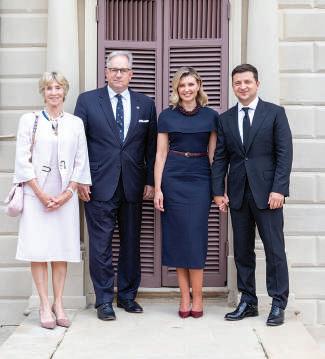
WASHINGTON’S
Clockwise from right: Washington’s globe, purchased in 1789; Prussian king Frederick the Great, an admirer of the General’s military genius; a portrait of Washington resigning his army commision; 19th-century British commemorative jug; the 2021 Mount Vernon visit of Volodymyr Zelenskyy and Olena Zelenska, president and first lady of Ukraine; and a French depiction of Washington on horseback.
During the Qing Dynasty, George Washington’s resignation proved he possessed “the virtues of the ancient Chinese sages.” He set a global precedent.
labeled Washington a dictator, it asserted: “Whatever Fortune may attend Gen. Washington’s Operations, or whatever Use he may make of those dictatorial Powers with which his deluded Countrymen have imprudently vested him, we cannot at present justly challenge either his Abilities as a Soldier, or his Principles as a Patriot.” And apparently to the French, every American looked like Benjamin Franklin, resulting in decorative statues of Washington with the scientist-diplomat’s likeness.
As Washington’s military victories spread, so did his fame. A poem published in Berlin declared him “Hercules Washington, the guardian god of freedom.” Nearly 200 years later, Chinese communist Mao and Vietnamese general Vo Nguyen Giap adapted Washington’s concept of revolutionary and hybrid warfare. But it was Washington’s surrendering of power, first as a general, and again in 1797 as the first U.S. president, that immortalized his legacy.
A Global Precedent
King George III was again taken aback by Washington again sur-
rendering power, this time calling Washington “the greatest character of the age.” Napoleon lamented in exile, “It was wished that I might become a Washington.” He failed. Ecuadorian politician Vicente Rocafuerte remarked, “Every superior manager will abuse the power when he can execute it with impunity, unless he is a hero like Washington.” During the Qing Dynasty, Washington’s resignation proved he possessed “the virtues of the ancient Chinese sages.” He set a global precedent.
After Washington’s death in 1799, the “father of his country” truly transcended borders. Artists, authors, and artisans from China and England to Italy and Japan produced Washington-themed portraits, statues, books, and porcelain. Those who knew him, like the Marquis de Lafayette in France and Tadeusz Kościuszko in Poland, as well as everyday Americans who traveled and traded, spread his legend far and wide. His name, if not his story, also followed George’s relative William Washington, fighting for Greek independence, as well as Harry Washington, who, having escaped
slavery under George, led a rebellion in Sierra Leone [see story, page 24]. Children—regardless of their country of origin—were named after him, including the second king of Siam’s son, Prince George Washington. Washington became, as Bolívar called him, “the first man in the Universe.”
Washington was an inspiration and a measuring stick. After the start of the French Revolution, Lafayette presented Washington, a father figure to him, with the key to the notorious Bastille, in tribute “as a Missionary of liberty to its patriarch.” In the French National Assembly, Count Alexandre de Lameth successfully petitioned for the removal of aristocratic titles, arguing that they “did not sound a bit better than” a name like George Washington. Even in Colombia, Bolívar (the Liberator of Latin America) played a supporting role, placed in “the temple of immortality at the right hand of Washington, the first hero of freedom.” Liberia, the African republic founded by formerly enslaved people, attributed its nationhood to Washington: “the heroes of Liberian independence acted under different circumstances and conditions, but the fundamental characteristics of those freedmen were forged alike in the thought and personality of Washington.”
Washington has also been misunderstood or his principles perverted, particularly in the 20th century. In 1972, Saudi Arabian delegates in the United Nations disputed the definition of terrorism by arguing “that Britain once regarded George Washington a terrorist.” The Soviet Union’s TASS news agency and Libyan dictator
WINTER 2022 | MOUNT VERNON LADIES’ ASSOCIATION 20 PRINCE: WIKIMEDIA COMMONS. STAMP: BIGSTOCK. PAINTING: WASHINGTON THE SOLDIER—BATTLE OF THE MONONGAHELA, CLAUDE REGNIER, AFTER STEARNS, 1854, MVLA. CHURCHILL: THE ROARING LION YOUSUF KARSH. KEY: MVLA, PHOTO BY GAVIN ASHWORTH
Muammar Gaddafi agreed. After leading a military coup, Korean general-turned-president Chun Doo-Hwan revealed to President Ronald Reagan, “Sir! I want to be Korea’s George Washington! I will keep my one-term pledge at any cost and be historically praised.” He gave no consideration as to how he had acquired power.
Certainly Washington had his detractors, particularly after 1793’s Proclamation of Neutrality. Still, slavery has been the most cited sin. Lafayette urged Washington to forgo the dreadful institution because “such an Example as Yours Might Render it a General Practice.” British poet Edward Rushton shamed Washington’s hypocrisy, “You took up arms in defence of the rights of man. Your negroes are men.” Washington’s will, written for a public audience, freed those he enslaved after his wife Martha’s death. It was published internationally. The Newcastle Weekly Courant exclaimed it exhibited “the sentiments of humanity” and showed “how much he had at heart the cause of his fellow creatures.” Two centuries after Washington’s birth, the Haitian newspaper Le Temps continued to depict him as an emancipator, “Washington prepared the way for Lincoln.” The world has historically offered largely praise. The most frequent criticisms originated from his own country in the modern day.




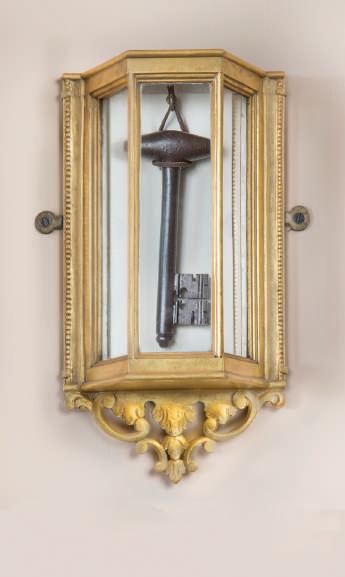
 GEORGE
Clockwise from right: Prince George Washington, son of the second king of Siam; a circa-1982 stamp from the Central African Republic; an engraving of the 1755 Battle of Monongahela, in which Washington’s bravery saved the British Army during the French and Indian War; British prime minister Winston Churchill; and the key to the Bastille, given to Washington by the Marquis de Lafayette.
GEORGE
Clockwise from right: Prince George Washington, son of the second king of Siam; a circa-1982 stamp from the Central African Republic; an engraving of the 1755 Battle of Monongahela, in which Washington’s bravery saved the British Army during the French and Indian War; British prime minister Winston Churchill; and the key to the Bastille, given to Washington by the Marquis de Lafayette.
What the World Needs Now
By the 20th century, the British had even claimed their former enemy. Winston Churchill used Washington as a symbol of U.S.U.K. unity, calling him “one of the glories of the English-speaking race,” while Prime Minister Clement Attlee referred to him simply as “the greatest of all Englishmen.” The former “rebel” was even acquitted of treason in a mock trial held at the British Inns of Court in 1990.
In September 2021, a barely known international dignitary named Volodymyr Zelenskyy visited Mount Vernon. He was just the latest in a long tradition of world leaders attempting to link themselves with George Washington. A little over a year later, Zelenskyy was accorded world hero status and labeled Ukraine’s George Washington for valiantly fighting for and leading his country.
In the 1780s, American poet Philip Freneau wrote of Washington, “Throughout the world thy growing fame has spread, In every country are thy virtue read.” By the 19th century, it was true. Imperfect though he was, Washington was and remains a hero for the world.
Craig Bruce Smith is a historian and the author of American Honor: The Creation of the Nation’s Ideals during the Revolutionary Era. He is working on his next book “The Greatest Man in the World”: A Global History of George Washington.
Washington’s Many Monuments
A TOUR OF THE MANY SHRINES TO GEORGE WASHINGTON AROUND THE GLOBE
In 1778, a 30-foot brick tower dedicated to Washington rose in Ireland. That was five years before Congress resolved to place a statue of Washington in front of the seat of government, 49 years before Boonsboro, Maryland’s Washington Monument—the first in the United States—was dedicated, and 106 years before the completion of the Washington Monument in Washington, D.C.
Constructed for Belcamp Hall, the estate of Edward Newenham, a member of the Irish Parliament, it was the first of its kind anywhere in the world. The monument was dedicated to General George Washington, who “Served the Cause of true Liberty,” in Newenham’s words. But it also spoke to a deeper purpose. It featured the inscription “Oh, ill-fated Britain! The folly of Lexington and Concord will rend asunder and forever disjoin America from thy empire.” It implied freedom could also come for Ireland. Today, the tower still stands—now a short five-and-a-half-mile drive from the Dublin airport—and it’s just one of many tributes to Washington that can be found around the world.
Whether on a street sign, a metal structure, or on a geological feature, Washington’s name or likeness can be found on every continent on Earth. (Yes, even Antarctica.) The tributes strewn around the world were often a physical display of international relations with the United States. And it wasn’t just diplomacy. As was the case in Ireland, these memorials spoke to a deeper ideological and nationalistic meaning.
The 1906 dedication of a Washington statue in Budapest drew a crowd of 30,000 people. In the aftermath of a Hungarian constitutional crisis, this monument served as a reminder that “the Father of the American Republic had influenced Louis Kossuth [a Hungarian revolutionary] and that by that standard Hungary’s greatness would be attained.” President Francisco Madero welcomed another statue to Mexico City as “the labor of Washington was one of the factors which caused France to seek and claim her freedom, radiating afterward to all the world, illuminating the minds of our own Hidalgo, Allende, Morelos, and other patriots.”
Washington can even be found in the heart of the British Empire. His statue was placed prominently in London’s Trafalgar Square in 1921 because he was “one of the greatest Englishmen that ever lived.” “Though he fought us and vanquished us,” Lord George Cuzon welcomed the statue since “[h]e was fighting for ideals and principles vital to all of us.”
WINTER 2022 | MOUNT VERNON LADIES’ ASSOCIATION 22




Where in the World


GEORGE WASHINGTON’S MOUNT VERNON 23 WASHINGTON RALLYING THE AMERICANS AT THE BATTLE OF PRINCETON WILLIAM T. RANNEY, 1848, PRINCETON UNIVERSITY ART MUSEUM
1. London: outside the National Gallery, in Trafalgar Square 2. Paris: with Lafayette, at the Place des États-Unis 3. Budapest: City Park, near the city center 4. Belgrade: street sign 5. Paris: an equestrian statue at the Place d'Iéna 6. Ireland: the first, at Belcamp Hall, in Balgriffin, in the northern suburbs of Dublin 1: TONY BAGGETT/ISTOCK. 2: WIKIPEDIA CREATIVE COMMONS. 3: DEZIDOR/WIKIPEDIA CREATIVE COMMONS. 4: JAN PEŠULA/CREATIVE COMMONS. 5: KEN WIEDEMANN/ISTOCK. 6. SOUTH DUBLIN COUNTY LIBRARIES—HTTPS://HDL.HANDLE.NET/10599/11200 ➊ ➋ ➌ ➍ ➎ ➏
In this contemporary painting by artist Marion Miller, Harry Washington saddles George Washington’s favorite horse, Nelson.

24WINTER 2022 | MOUNT VERNON LADIES’ ASSOCIATION HARRY WASHINGTON SADDLING NELSON MARION MILLER, 2020, MVLA, DONATED IN HONOR OF MARY THOMPSON’S LEGACY
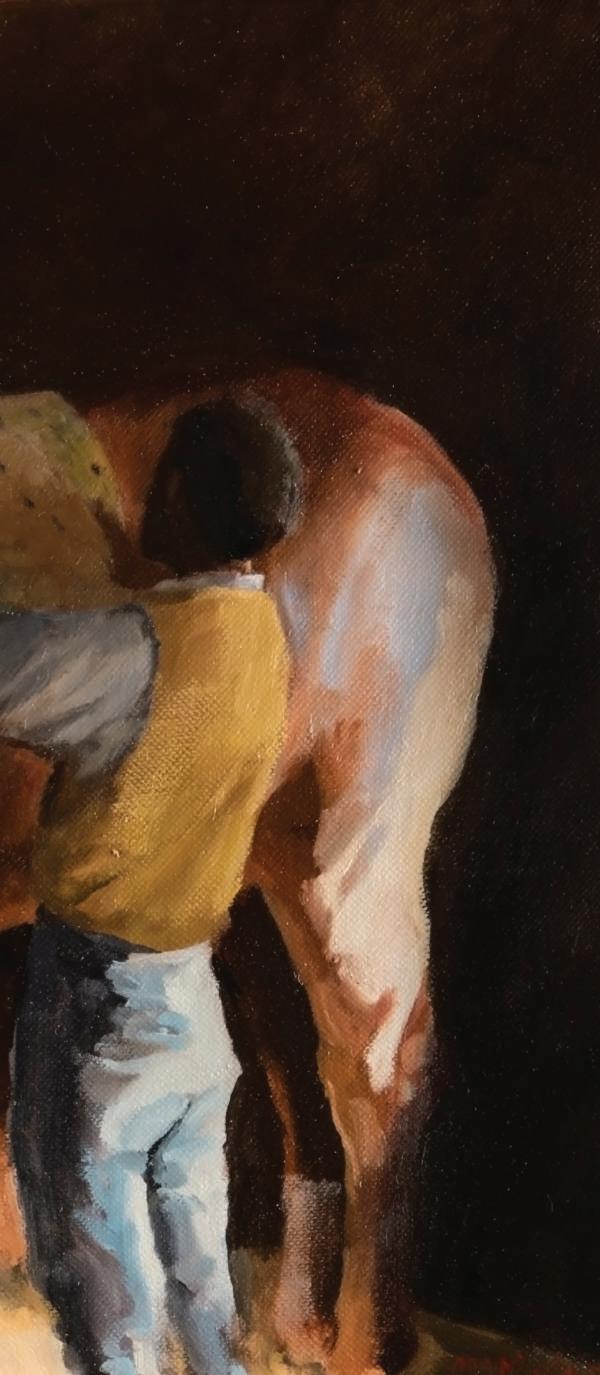
Harry Travels Washington with
Like his enslaver, he fought against oppression, but did so by joining—rather than opposing—the British
BY JOSEPH J. ELLIS
GEORGE WASHINGTON’S MOUNT VERNON 25
GLOBAL AFFAIRS
In august of 1776, two men named washington made dramatic and improbable escapes. The more famous Washington ordered a strategic retreat of the Continental Army across New York’s East River. The maneuver, performed at night under a providential fog, effectively avoided the capture or annihilation of Washington’s forces on Long Island. Had that happened, the American Revolution might very well have ended there, before it had barely begun.
Two weeks earlier, in Virginia, Washington’s enslaved namesake at Mount Vernon staged his own escape, on another river, the Potomac. But Harry Washington was not fleeing the British Army; he was, instead, seeking to join it. More specifically, he intended to enlist in the Ethiopian Regiment, an all-Black unit, hundreds strong, created by Lord Dunmore, the royal governor of Virginia, who, less than a year before,
had offered freedom to all Virginia slaves of American revolutionaries who escaped and joined the royal forces. When word spread through the enslaved community at Mount Vernon that Dunmore’s fleet was anchored at the mouth of the Potomac, that was all that Harry needed to know. He commandeered a small skiff, presumably kissed his wife goodbye, and sailed toward freedom, thereby declaring his own independence.


Freedom for Whom?
The juxtaposition of the two Washingtons, both making bold dashes for freedom, exposes the moral paradox that slavery posed at the nation’s founding. George Washington believed, with good reason, that he was fighting for American liberty from British tyranny. And Harry Washington believed, with equally good reason, that Great Britain represented a
WINTER 2022 | MOUNT VERNON LADIES’ ASSOCIATION 26
A scene of Mount Vernon's farm fields (above), where the enslaved Harry Washington labored. Following his escape from Mount Vernon, he enlisted with Lord Dunmore’s Ethiopian Regiment. No depictions exist of this British regiment, but during the Revolutionary War, thousands of African Americans fought on the British side (above right) as well as with the Continental Army.

proximate and palpable solution to America’s unique form of tyranny.
Taken together, the two Washingtons embodied the double-edged sword that Americans were calling “The Cause,” a mutable, conveniently ambiguous principle that afforded an umbrella under which different, and often conflicting, convictions and goals could coexist.
More panoramically, it was clear that the values of The Cause were
incompatible with the continuation of slavery, and Washington, as well as the most prominent Virginians who owned enslaved people, including Thomas Jefferson, George Mason, and Patrick Henry, acknowledged that fact. The American Revolution was forcing the founding generation to face a moral question that had been ignored or suppressed throughout the civilized world for most human history: Can a just society continue
to tolerate the institution of slavery?
Across the globe—in Asia, the Middle East, Africa, and Europe— enslaving others had been an unquestioned tradition. And while there were religious leaders, primarily Quakers and so-called New Light ministers, who described the slave trade and slavery itself as a blatant moral travesty, prior to the American Revolution, such voices were howling in the wilderness.
GEORGE WASHINGTON’S MOUNT VERNON 27 PLANTATION: WASHINGTON, THE PLANTER, LOUIS C. ROSENBERG, 1932, MVLA, PURCHASED WITH FUNDS FROM THE HON. AND MRS. TOGO D. WEST, JR., 2012. BATTLE: THE DEATH OF MAJOR PEIRSON, 6 JANUARY 1781, JOHN SINGLETON COPLEY, 1783, TATE
There’s Something About Harry
We obviously know a great deal about George Washington’s life after 1776. Harry Washington, on the other hand, disappears into the mists of the middle distance. But thanks to the prodigious research of Australian historian Cassandra Pybus, we now know what happened to him. As it turns out, he embarked on an epic globe-trotting odyssey equal in rebellion and heroics to that of his former enslaver.
We know that Harry was born circa 1740, in Senegambia, in northwest Africa. His African name and tribal affiliation remain a mystery. He was purchased by George Washington in 1763 to serve as a laborer in the Great Dismal Swamp, a malaria-riddled wetland in southeastern Virginia in which George was involved in a land speculation venture. Three years later, in 1766, he was brought back to Mount Vernon to work as a hostler, or caretaker of horses. He made an attempt to escape in

1771 but was caught within days. Harry soon thereafter married a fellow enslaved woman named Nan, and fathered a son. He never saw them again following his escape in 1776.
By the time Harry joined the Ethiopian Regiment, whose uniform included a sash inscribed with the words, “Liberty to Slaves,” it was already on the verge of collapse, partly because of Dunmore’s ineptitude, but mostly because of a virulent smallpox epidemic that wiped out more than 50 percent of the volunteers. Harry was one of the survivors who were then brought to the British headquarters in New York. There he was made a corporal in the Black Pioneers, a Loyalist regiment attached to the Royal Artillery. The British Army seldom allowed African Americans to serve in combat units, therefore Harry’s duties probably involved providing support for the movement of cannons and munitions. In this capacity, he was assigned to the British force that laid siege to
Following the Revolutionary War, Harry Washington landed in Birchtown, Nova Scotia (this image), where he lived for some years before boarding another ship to Sierra Leone (opposite).
Charleston in 1780. He remained with the occupation force there until its evacuation in 1782.
Epic Journeys
He was back in New York in 1783, when the Treaty of Paris officially ended the war. With the British defeated and the victorious Patriots clamoring for the return of their escaped property, the fate of Harry Washington and others who fought on the British side was unclear. However, the British kept their promise. On July 31, Harry boarded the British ship L’Abondance bound for Nova Scotia. There he lived for almost a decade in the Black Loyalist community of Birchtown, the largest free settlement of ethnic Africans in North America in the 18th century. He subsequently met and married Sarah, also a former slave, and fathered three children, while working a small farm.
But constant maltreatment and harassment from white settlers in nearby Shelburne, plus difficulty with the harsh Canadian winters and rocky soil, prompted a protest by many in the community and a subsequent exodus of some 1,000 Black Loyalists to the British colony of Sierra Leone in 1792. Harry and his family joined the exodus. A year later, he owned a small farm outside the newly named Freetown.
Here the record goes quiet for eight years. Then, in 1800, Freetown residents staged a protest against the Sierra Leone Company, which ran the colony for the Crown, claiming they were being taxed without consent— an intriguing echo of the complaints George Washington and the other founders made years earlier. Harry joined the protest, which was ultimately suppressed by Jamaican troops serving as British conscripts. He appears in the court records as one of the rebel ringleaders, many of whom were executed for treason.
Homecoming
Harry escaped that fate. He was sentenced by a military tribunal in October of 1800 to exile to the Bullom Shore, outside of Freetown. By then he was over 60, with multiple children and grandchildren. We know he was elected leader of the exiled community during that time. His final years were spent only a few miles from the notorious prison camp where he had been held before boarding the slave ship that carried him to Virginia 50 years earlier.
His final years were spent only a few miles from the notorious prison camp where he had been held before boarding the slave ship that carried him to Virginia 50 years earlier.

More than two centuries since his escape, Harry Washington has returned to Mount Vernon in the form of a portrait, which is now on display in the Fred W. Smith National Library for the Study of George Washington. It will provide the opportunity for visitors to learn about the long-lost other Washington. Before the word “globalization” existed, Harry Washington lived its meaning in his odyssey as both an African and an American, as well as his tireless quest to embrace transcendent and universal values that defy time and place.
Joseph J. Ellis has won both the Pulitzer Prize and the National Book Award. He is the author of the New York Times bestseller His Excellency: George Washington and, most recently, The Cause: The American Revolution and Its Discontents.
GEORGE WASHINGTON’S MOUNT VERNON 29 BIRCHTOWN HARBOR: PHOTO © NORIE QUINTOS. DRAWING OF WESTERN AFRICA, CIRCA 1820-1850, MSS 14357, SPECIAL COLLECTIONS, UNIVERSITY OF VIRGINIA LIBRARY, CHARLOTTESVILLE, VA.

The Lafayette Room, as it may have looked in 1799, based on documentary evidence, paint analysis, and years of painstaking research.
A Noble
30WINTER 2022 | MOUNT VERNON LADIES’ ASSOCIATION
PHOTOS BY BRANDON HULL

Room
The Marquis de Lafayette’s bedroom returns to its former glory
BY AMANDA ISAAC
31
GLOBAL AFFAIRS
Period chairs from the shop of Robert Walker, of Fredericksburg, Virginia, highlight Washington’s occasional purchase of “country-made” furniture.
When the Marquis de Lafayette arrived at Mount Vernon, he wrote home to his wife Adrienne in the summer of 1784 that he was “reveling in happiness” at again seeing “mon cher général” George Washington. The joyous reunion and the honor conferred by the French nobleman’s stay made a deep impression on the Washingtons and their household.
Lafayette’s visit, split over a few weeks in August and then November, formed part of a five-month postwar celebratory tour of the country he had helped bring into being. Lafayette traveled from Boston to Richmond, meeting with old friends and comrades, networking, and strengthening political and commercial ties between France and the new United States. The highlights of the tour were his long-anticipated visits to Mount Vernon. Here at last, the 27-year-old Lafayette and the 52-yearold Washington could enjoy the pleasure of each other’s company without the extreme pressures of war, with time for extended conversations and reminiscences amid the leisure and tranquility of family life in the country. When they parted on November 28, they suspected they likely would not see each other again.
Visitors today can experience this lieu de memoire, or place of memory, in all its complexity.

WINTER 2022 | MOUNT VERNON LADIES’ ASSOCIATION 32

GEORGE WASHINGTON’S MOUNT VERNON 33
Thereafter, the bedchamber where Lafayette stayed, in the northeast corner of the second floor, would be associated with its most famous occupant. In fact, the Washingtons had their prized portrait of the Marquis moved into the room. Without fanfare, it became the first domestic space to commemorate this man who meant so much to the Washingtons and to the new country, and by extension, the personal bonds that formed the basis of the Franco-American political alliance. Twelve years after Lafayette’s visit, his son, Georges Washington Motier Lafayette, arrived at Mount Vernon as a refugee from the revolution in France, while his father was imprisoned. It is unclear where he may have slept while at the estate. Nevertheless, in the midst of this dark time, the family continued to remember the room as the one the “Marquis Delafiat Lodged In.”
On July 14, 2022, Bastille Day, Mount Vernon’s preservation and curatorial teams unveiled the results of a multiyear project of research, cosmetic architectural treatments, and reinstallation of the Lafayette Room, utilizing extensive documentary evidence, paint analysis, and other information to recover its multilayered history and present its appearance as it would have looked in 1799. Visitors today can experience this lieu de memoire, or place of memory, in all its complexity. The nearly life-size portrait of Lafayette retains pride of place, while the distinctive wallpaper and furnishings signal the room’s frequent use as a bedchamber for people from many walks of life, from international guests to close kin.

Key Figure
A timeline of the remarkable life of the Marquis de Lafayette, French nobleman, military aide and surrogate son to Washington, and defender of democratic ideals.
1757 Gilbert du Motier was born to one of France’s oldest families.
1770 By age 13, following the deaths of his parents and other family members, Lafayette inherited one of France’s largest fortunes.
1773 Never impressed with status or riches, he longed for military glory. He won a captain’s commission in the French Army and was appointed to the Black Musketeers.
A Changing Space
The room took shape with Washington’s first major building campaign, which began in 1758 and likely continued into the 1760s. As initially constructed, it featured a sweeping view of the Potomac River from two windows on the east wall, and a view of the grounds and outbuildings as well, from a third window on the north wall. Early orders by the Washingtons suggest the room was initially wallpapered with a blue and white pattern. The construction of the north wing, or New Room, from 1775 to 1776, closed up the north window, and the addition of the covered piazza between 1777 and 1778 shaded the room from the direct morning light it had previously received. In 1797, Washington updated the fireplace, together with others throughout the house, with a Rumford insert, intended to heat the room more efficiently. Amid these changes, the Washingtons also repainted the woodwork and updated the wallpaper about every 10 years, with the last major refurbishment occurring in 1797, after Washington retired from the presidency.
Stream of Visitors
As the largest room on the second floor apart from the Washingtons’ own bedchamber, it was one of the more desirable spaces for guests, but the association with Lafayette gave it added attraction. Many of the hundreds of men and women who came to pay homage to Washington stayed in this room. Few of their names were recorded, but Thomas Handasyd Perkins, a Boston merchant who visited in July 1796, recalled staying in the room where
1774 He married Adrienne de Noailles, a woman from an even more renowned family.
1775 He attended a dinner at which the younger brother of British king George III complained about the American colonists. The event changed his life. “My heart was enlisted and I thought only of joining my colors to those of the revolutionaries,” he later wrote.
1777 Lafayette sailed for America and became a military aide to
General Washington. He was with him during the winter at Valley Forge and through much of the Revolutionary War.
1778 Lafayette was overjoyed when news of the French alliance arrived. He returned to France to rally more support for the United States.
1781 He returned to the United States, and Washington sent him to harass British forces until Washington could lay siege to
WINTER 2022 | MOUNT VERNON LADIES’ ASSOCIATION 34
FACE: PORTRAIT OF MARQUIS DE LAFAYETTE, CHARLES WILLSON PEALE, CIRCA 1779, MUSEUMS AT WASHINGTON AND LEE UNIVERSITY. FAMILY SCENE: WASHINGTON AND LAFAYETTE AT MOUNT VERNON, 1784, THOMAS PRITCHARD ROSSITER, 1859, METROPOLITAN MUSEUM OF ART, BEQUEST OF WILLIAM NELSON. TOMB: LAFAYETTE AT THE TOMB OF WASHINGTON, NATHANIEL CURRIER, 1845, LIBRARY OF CONGRESS

Lafayette’s portrait hung. “I do not think I slept at all, so much was I occupied with the occurrences of the day,” Perkins later declared, referring to his conversation with his hero, Washington.
The placement of Perkins in a room of honor was likely no idle choice. He had been instrumental in assisting Lafayette’s son, Georges, to find refuge in the United
States. The 16-year-old refugee and his tutor arrived at Mount Vernon in the spring of 1796, and stayed with the Washingtons until the fall of 1797. Seeing the portrait of his father may have been a comfort to the son.
Mrs. Lewis’s Room
In preparing for the restoration of the room, curators
them at Yorktown. After Cornwallis’s surrender, which effectively ended the war, he returned to France as a national hero.
1784–1785 On a tour of the U.S., he visited Washington at Mount Vernon. “Our meeting was very tender and our satisfaction was mutual.” Like Washington, he favored the creation of a strong central government. But unlike Washington, he recommended an immediate end to slavery.
1789 Back in France, Lafayette helped launch the French Revolution, serving in the National Assembly and drafting the Declaration of the Rights of Man. He sent Washington, then president of the U.S., the key to the Bastille.
1792 As the French Revolution turned radical and violent, Lafayette was imprisoned and his fortune confiscated. Appeals from Washington and other U.S. diplomatic efforts gained him better treatment. Many of Lafayette’s
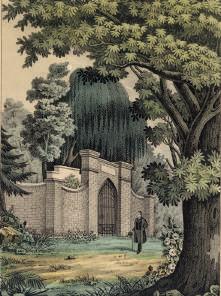
relatives died by guillotine, but his son escaped to the U.S. Lafayette was eventually freed and settled at La Grange, an estate near Paris.
1824 On yet another trip to the U.S., he visited Washington’s grave at Mount Vernon (left).
1834 He died at age 76 in Paris, and was buried under soil from Bunker Hill (the opening stage of the Revolutionary War), which his son Georges sprinkled on him.
GEORGE WASHINGTON’S MOUNT VERNON 35
An 1859 painting of Washington and Lafayette at Mount Vernon offers a romanticized version of the 1784 meeting between the two generals.
sought to determine the room’s appearance and use in 1799, 15 years after the elder Lafayette’s visit. Several documents provided critical clues, beginning with an 1872 letter from Betsey Mason, Vice Regent from Virginia, to Superintendent Col. James Hollingsworth. Mason, whose home was at nearby Huntley plantation, was a contemporary and friend of Frances Parke Custis Lewis Butler, who was born at Mount Vernon and the first child of Eleanor (Nelly) Parke Custis Lewis, Martha Washington’s granddaughter. In her November 27 letter, Mason noted that the northeast room on the second floor had previously been “Mrs. E P Lewis’s chamber…the room in which my dear friend Mrs. Butler was born—& in which Major & Mrs Lewis slept until they left Mt. V—n for Woodlawn.”
This letter provided the missing piece of a puzzle, confirming where the newly married couple, Eleanor Parke Custis and Lawrence Lewis, had stayed at Mount Vernon after their marriage and while waiting for their own home to be built, between the fall of 1799 and the summer of 1802. Supporting evidence could be found in the probate inventories taken after the deaths of George Washington in December 1799, and Martha in May 1802. In addition to the “likeness of Genl Fayette” valued at $50, the room included a customary set of chamber furnishings, with a high-post bed, a dressing table, looking glass, four side chairs, and an armchair. Notably, the bed, bedhangings, and chairs were valued at less than the comparable items in other rooms. In the 18th century, the most impressive furnishings were typically placed in guest bedchambers in a hierarchical fashion, from best to second-best, and so on. Rooms used by long-term residents or family members typically had less showy furnishings. The less valuable furnishings in this room thus correlated with its use by family members in 1799. With this new understanding, the curatorial team aimed to accurately represent the comfortable but modest furniture used in a room occupied by close family.
Paint and Paper
Paint analysis of the woodwork identified five layers of early paint. The paint layer corresponding to the renovations around 1797 was a cream or stone color, similar to that used in each of the other second floor bedchambers and the passage. For the wallpaper, curators
selected a sophisticated sprig wallpaper in widespread use in elite homes in the 1790s. The black-and-white design on a gray background, accented with a deep pink, features a motif inspired by the serrated boteh (stylized single flower) of Persian and Indian textiles. Fellow Federalists evidently favored the pattern, possibly the production of an American printer around the years 1785 to 1795. Oliver Ellsworth—the third chief justice of the United States— installed it at Elmwood, his home in Windsor, Connecticut. It also appeared in the family home of Colonel Timothy Pickering, secretary of State and War under Washington, in Salem, Massachusetts. Another example, with a blue accent, was recovered from a Philadelphia home and is now in the collections of Philadelphia’s Independence National Historical Park. A similar design appears in Charles Willson Peale’s The Staircase Group, a trompe l’oeil portrait of his sons.
The Portrait
In the Mansion’s five other bedchambers, a selection of fine engravings adorned the walls. In the Lafayette Room, there was only one recorded image: the nearly life-size portrait of the Marquis as a major general in the Continental Army. Washington himself had commissioned the painting during the Revolution, and artist Charles Willson Peale arranged for life sittings with Lafayette in 1778 and 1780. Peale completed the portrait in 1781, and initially, the Washingtons installed it in the Front Parlor, visually confirming Lafayette’s status as one of the family, arrayed alongside portraits of General and Mrs. Washington and the Custis children. This was the first impression grandchildren Eleanor Parke Custis and George Washington Parke Custis, then aged five and three, respectively, had of the Marquis. “It was rather amusing, when I arrived,” wrote Lafayette, “to see the curiosity of
THE RESTORATION OF THE LAFAYETTE ROOM WAS GENEROUSLY SUPPORTED BY KAREN M. AND JEFFERSON W. KIRBY, THE FLORENCE GOULD FOUNDATION, THE FELICIA FUND, THE BROWN FOUNDATION, THE FRENCH HERITAGE SOCIETY, THE ESTATE OF PAUL AND SALLY HOUDAYER, MR. AND MRS. S. DILLARD KIRBY, THE GEORGE L. SHIELDS FOUNDATION, AN ANONYMOUS DONOR, AND OTHERS.
WINTER 2022 | MOUNT VERNON LADIES’ ASSOCIATION 36
The black-and-white design on a gray background, accented with a deep pink, features a motif inspired by the serrated boteh (stylized single flower) of Persian and Indian textiles.

these two little ones, who had heard me spoken of all day and were very anxious to see if I looked like my portrait.”
In 1785, the year after Lafayette’s visit, the Washingtons received an extraordinary gift from the Lafayettes: a large family portrait depicting themselves and their young children. To make space for the new canvas in the Front Parlor, the Washingtons moved the portrait of the Marquis to the room in which he had stayed. The original Lafayette portrait is now in the collection of Washington and Lee University, and is currently on loan and on view in Mount Vernon’s newly installed exhibit, Mount Vernon: The Story of an American Icon. In its place, a high-quality reproduction in a period-appropriate frame gives visitors
a glimpse of the young man whom Washington so deeply admired and loved.
Furnishings
For the bed and bedhangings, curators chose to represent a suite the Washingtons acquired for their granddaughter Eleanor Custis’s use while living in Philadelphia in the 1790s. Distinguished by sleek, mahogany-columned footposts and crimson and white striped hangings, it re-creates documented Philadelphia examples from the 1780s and 1790s. The fabric selected is a reproduction striped cotton. Striped fabrics were one of the most common choices for bedhangings in the period. While considerably less expensive than multicolor prints or shimmering silks, woven stripes effectively brought a neat formality to any space. In the Lafayette Room, matching window curtains and slipcovers on the chairs complete the handsome unified effect the Washingtons consistently sought for their home’s interiors.
A remarkable set of four period walnut chairs from the shop of Robert Walker in Westmoreland County, Virginia, also stand in the room. Their rich patina and the scrolling silhouettes of their back splats bring to life the rare documented Washington purchases of furniture crafted in Virginia (“country made”) and used in some of the bedchambers. A period looking-glass (mirror) and an English dressing table, each of the style and form preferred by the Washingtons, round out the set of furniture used in the chamber.
Gallic Touch
The French influence appeared everywhere at Mount Vernon, in both conspicuous and subtle ways, from the beautifully framed print of King Louis XVI and the magnificent French plate-glass mirrors in the New Room, to the Bastille key and drawing in the Central Passage, from the dressing table and writing table in the Washingtons’ private wing, and the Sèvres, Niderviller, and Angouleme porcelain that elevated the dining and tea tables at meals, to the French papers that enlivened the walls throughout the house. Nowhere was it more personal and poignantly expressed, though, than in the Lafayette Room, where the presence of the Marquis persisted in his likeness and the memories that the family passed down.
GEORGE WASHINGTON’S MOUNT VERNON 37
Amanda Isaac is Mount Vernon’s associate curator.
Global Lessons
A middle-school teacher in Dakar, Senegal, demonstrates how George Washington’s legacy resonates beyond U.S. borders
The spouse of a diplomat, Jeff Meade has lived in many parts of the world. In his current post in Dakar, Senegal, he teaches middle school social studies and language arts at the Lycee Jean Mermoz. He takes an interdisciplinary approach to George Washington, offering students insight into his historical significance and a project-based lesson on the nature of utopias.
How do you incorporate George Washington into your teaching? In eighth-grade social studies, we look at Washington’s role in shaping a new nation as its first president and the process of creating a democracy. His Farewell Address is an excellent source for discussing the nature of liberty and the actions required to maintain the ideals espoused in the Declaration of Independence.
Tell us about your utopia project. One of the benefits of teaching both social studies and language arts is that I can blend subjects together. We look at the creation of the U.S. in social studies, while reading Lois Lowry’s The Giver in language arts. I then ask the students to design their own perfect society. During this project, they conduct a virtual interview, via video conference, with Mount Vernon’s vice president of education, Allison Wickens, to explore the concept of liberty in a utopia. Because, really, this is what Washington was the first president of—a utopian society based upon Enlightenment ideas of citizenship and limited government.
How do you make 18th-century events in the U.S. resonate with young people in Senegal? I use American history as the case study, so we look at the development of government and country as part of our larger utopia unit. But we also debate issues about what effective citizenship looks like and what rights
are most important. That’s not just an American issue of the 18th century, but also one for the countries of the world today. We look at a range of rights-based issues, especially concerning racism and LGBTQ+. Those issues resonate with young people, because they are the future leaders of the world.
What do you hope students take away from your classes? Learning is something we do throughout our lives. It isn’t just restricted to a time or place—our school years, for example. Learning is what active citizens do, constantly questioning what they know and what they think they know.
How do you communicate George Washington’s impact on world history? One of the things we discuss with Allison Wickens during our interview with her is that George Washington can be viewed from a variety of angles. He was the first president, with a huge responsibility. We read Washington’s Farewell Address to understand why he chose to step down and what his advice for the country was. We look at his role in advocating for democracy, freedom, and citizenship while he himself was the owner of enslaved peoples. There’s a conflict there that we discuss, and question the nature of what “freedom” actually means. And most of all, we discuss history as the present, because the legacy of freedom is something we need to fight for every day. In that regard, George Washington is just as important now as he’s ever been.
WINTER 2022 | MOUNT VERNON LADIES’ ASSOCIATION 38 Washington in the Classroom PHOTO COURTESY OF JEFF MEADE
YOUR SUPPORT OF MOUNT VERNON PROVIDES RESOURCES AND PROFESSIONAL DEVELOPMENT TO TEACHERS ACROSS THE COUNTRY. VISIT MOUNTVERNON.ORG/DONATE

GEORGE WASHINGTON’S MOUNT VERNON 39
Schoolteacher Jeff Meade, photographed while on summer break in Duck, North Carolina.
GLOBAL AFFAIRS
Farm to Table Fundraiser
Life Guard
Society
supports restoration of kitchen
On September 17, the Life Guard Society for Historic Mount Vernon hosted more than 300 guests for its annual gala fundraiser, which raised more than $500,000 to support the curatorial restoration of the Washingtons’ kitchen.
The event featured alfresco cocktails, a seated dinner on the east lawn overlooking the Potomac River, fireworks, and tours of the Mansion and kitchen. The evening’s guest chef was Patrick O’Connell, of the Inn at Little Washington—the only three-star Michelin restaurant in the greater Washington, D.C., region. The celebrated chef incorporated fruits, vegetables, and herbs harvested from Mount Vernon’s gardens into the dinner menu.
Historically, the kitchen at Mount Vernon was
used to prepare all meals served to George and Martha Washington and their many guests. It was housed in a separate building connected to the main house by a protected walkway. The restoration project will present the kitchen as a bustling hub of activity so that visitors, including schoolchildren, will gain a deeper understanding of history by learning about the food of the period, how it was prepared and by whom, and the ways in which the kitchen was the heart of Mount Vernon.
TO LEARN MORE ABOUT THE LIFE GUARD SOCIETY, VISIT MOUNTVERNON.ORG/LIFEGUARD

WINTER 2022 | MOUNT VERNON LADIES’ ASSOCIATION 40 Shows of Support
Doug Bradburn and the Honorable Elaine Chao

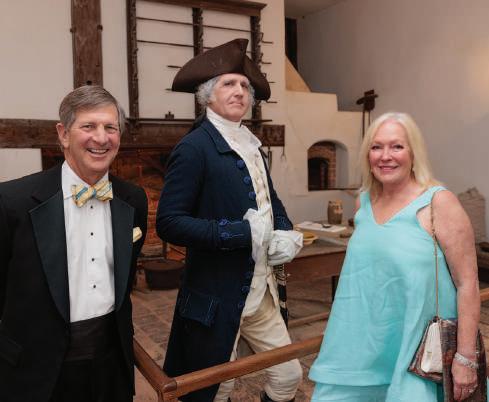



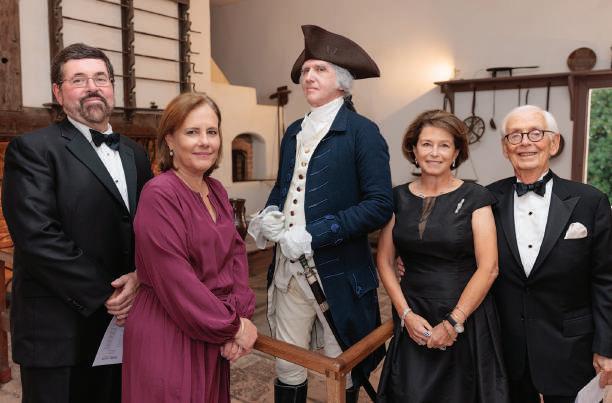
GEORGE WASHINGTON’S MOUNT VERNON 41
Top to bottom: Peter Alexander and wife Alison Starling. Danny Korengold and Martha Dippell. Chef Patrick O’Connell. Lee and Toni Verstandig, Paul and Leslie Kiernan with "General Washington". Cate Waddell, Vice Regent for Illinois. Hillary West, Vice Regent for the District of Columbia and friends.
PHOTOS BY DAN CHUNG
Tunes on the Bowling Green
Members enjoy an after-hours concert at Mount Vernon
June 26 was a typical summer evening in Mount Vernon, hot and humid with the threat of a storm. The rain held off, and several hundred guests were treated to a rollicking show by country act Martin and Kelly. Mount Vernon members were taking advantage of a special membership benefit: select summer evenings for “after hours” enjoyment, including free outdoor concerts.
Popular crossover country duo Jilly Martin and Ryan Brooks Kelly performed covers such as the Dolly Parton classic “I Will Always Love You” to their own composition dedicated to veterans, “Stood Their Ground.”
“Our experience performing at George Washington’s

Mount Vernon is one we will always remember,” said the artists afterward. “The magic in the history of the property is palpable, and being able to provide entertainment, with Mount Vernon as a backdrop, is something out of a storybook. Hopefully, our performance was something General Washington himself would have enjoyed.”

WINTER 2022 | MOUNT VERNON LADIES’ ASSOCIATION 42 Shows of Support
Nashville-based duo Martin and Kelly (top) entertained guests on the Mansion's lawn on a warm summer evening (above).
PHOTOS BY MATT BRINEY
THIS PERFORMANCE WAS SPONSORED BY JACQUELINE B. MARS. TO WATCH THE CONCERT, VISIT MOUNTVERNON.ORG/MEMBERCONCERTS



Film Screening in Rhode Island
The Newport premiere of Mount Vernon’s film about religious freedom holds special relevance
Regional premieres of Mount Vernon’s 16-minute educational film, George Washington and the Pursuit of Religious Freedom, continued with a screening at the Jane Pickens Theater, in Newport, Rhode Island, on July 28.
The location had special significance. Newport is the home of the Touro Synagogue, the oldest synagogue in the United States. George Washington’s 1790 letter
of response to its Jewish congregation has become renowned for reinforcing the ideal of religious liberty in American life. In it, Washington, who came to be a champion of religious freedom, famously declared that the government of the United States “gives to bigotry no sanction, to persecution no assistance.”
Re-enactors involved in the filming greeted guests. Following the screening, Kevin Butterfield, executive director of the Fred W. Smith National Library for the Study of George Washington at Mount Vernon, and Christopher Grasso, professor of history at Brown University, discussed Washington’s legacy, the role of the Touro Synagogue, and the continued importance of religious freedom.
GEORGE WASHINGTON’S MOUNT VERNON 43
TO WATCH THE FULL FILM, VISIT MOUNTVERNON.ORG/RELIGIOUSFREEDOMFILM PHOTOS BY CHRIS SCHNEIDER
Following the film screening (above), Kevin Butterfield (top right) and Christopher Grasso (above right) discuss the role of the Touro Synagogue.
Royal Welcome
Just months before she would ascend to the throne, a British princess visits
Mount Vernon
On November 1, 1951, Mount Vernon hosted 25-yearold Princess Elizabeth of the United Kingdom and her husband, Phillip, the Duke of Edinburgh. Their 40-minute visit, accompanied by Hope Powel, then Regent of the Mount Vernon Ladies’ Association, and Charles C. Wall, resident director, drew a crowd of reporters and spectators. The royal couple arrived by car at 10 a.m. and immediately proceeded to Washington’s Tomb to lay a wreath. The couple continued into the Mansion for a private tour. They met with 20 members of the MVLA, signed the guest book, and received a gift from the Regent on behalf of the Association. Afterward, the princess met with reporters and photographers on the piazza. Mount Vernon staff planned for extra security and received the assistance of 30 uniformed police officers to ensure the royal couple’s safety while leaving the site open for the public to see the princess, and provided reporters time to take pictures and ask the royal couple questions. The royals would continue on to Arlington Cemetery and other monuments around Washington, D.C.
Only a few months later, in February 1952, Princess Elizabeth would become Queen Elizabeth II. It would be another 40 years before Her Majesty and Prince Phillip returned—in 1991—to dedicate the newly renovated wharf at Mount Vernon.
Today, the United States has no closer ally than the United Kingdom. Following the end of the War of 1812, the two countries became durable partners founded on common democratic ideals and values and a mutual desire for prosperity and security. Visits by diplomats and royalty only solidify the historical bonds between the two nations.
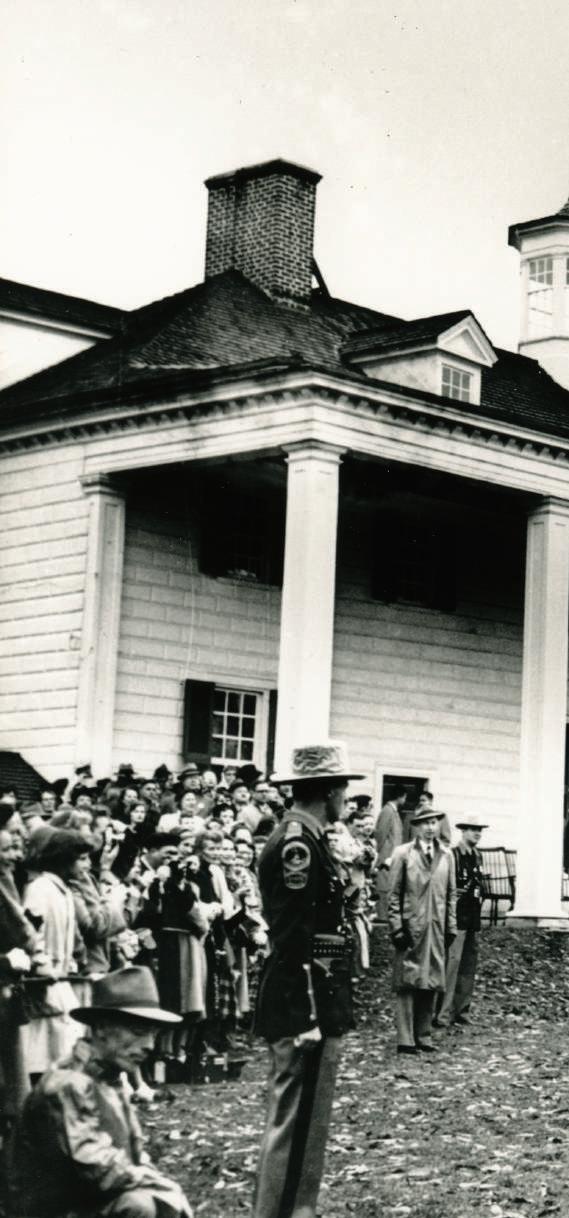
WINTER 2022 | MOUNT VERNON LADIES’ ASSOCIATION 44 Featured Photo
MVLA
GLOBAL AFFAIRS
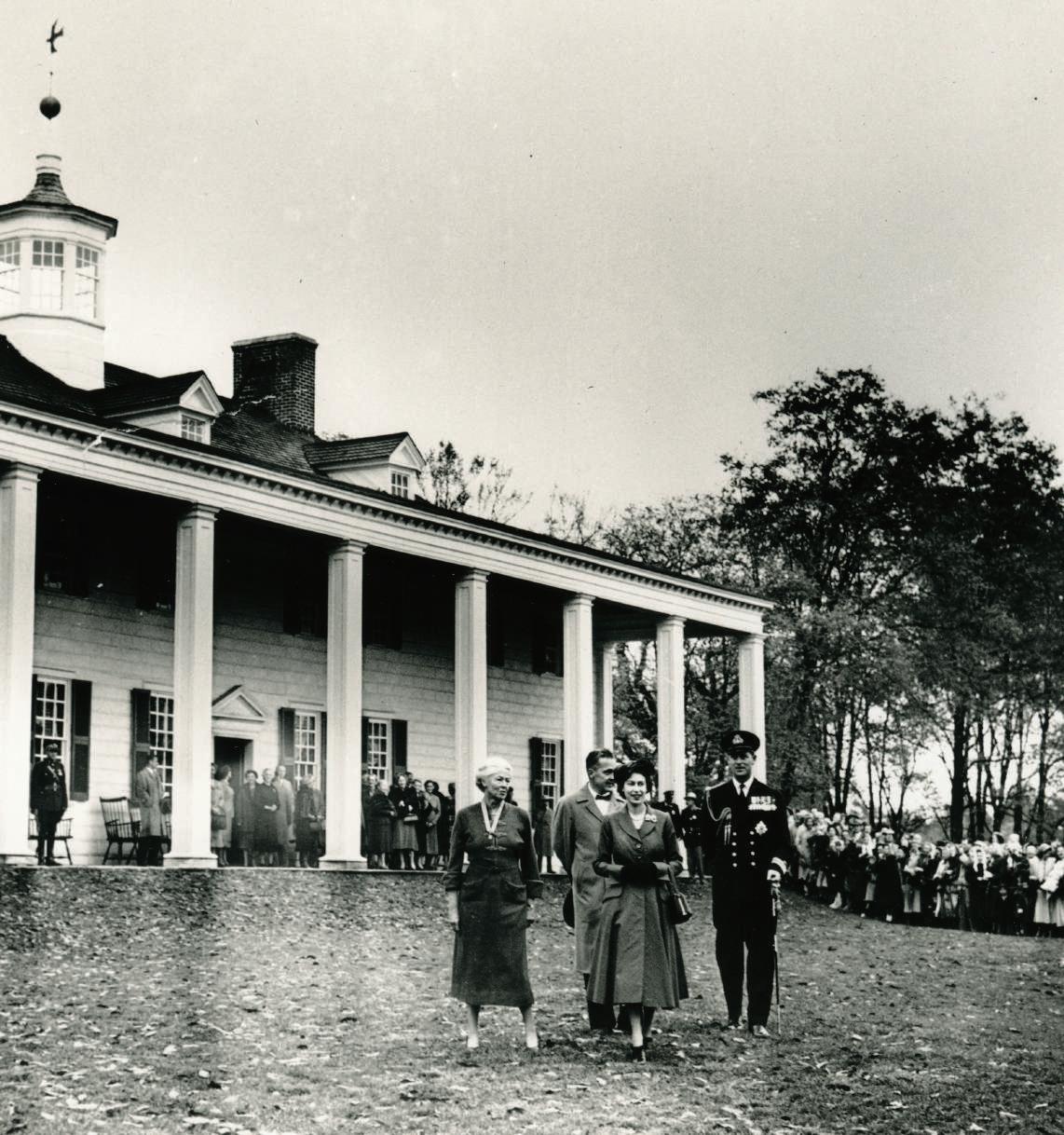
DID YOU KNOW?
THE FIRST VISIT OF A REIGNING BRITISH ROYAL TO MOUNT VERNON WAS ELIZABETH’S FATHER GEORGE VI IN 1939 AND THE SECOND WAS ELIZABETH’S RETURN VISIT IN 1991. READ MORE ABOUT THESE AND OTHER ROYAL VISITS AT MOUNTVERNON.ORG/ROYALVISITS
While on a two-day visit to the Washington, D.C., area in 1951, Princess Elizabeth and the Duke of Edinburgh stop at Mount Vernon.
.
MOUNT VERNON LADIES’ ASSOCIATION
P.O. Box 110, Mount Vernon, Virginia 22121
George Washington holds one of the proudest titles that history can bestow. He was the Father of his Nation.... He filled his office with dignity and inspired his administration with much of his own wisdom.
Winston Churchill, in his book A History of the English-Speaking Peoples









 Douglas Bradburn President and CEO
Douglas Bradburn President and CEO



























 Monika and Tim Stoy, with Monika’s mother Haesook Choi, at the Mansion’s colonnade.
Monika and Tim Stoy, with Monika’s mother Haesook Choi, at the Mansion’s colonnade.
 GEORGE WASHINGTON, WALTER KERR COOPER, 1997
GEORGE WASHINGTON, WALTER KERR COOPER, 1997











 GEORGE
Clockwise from right: Prince George Washington, son of the second king of Siam; a circa-1982 stamp from the Central African Republic; an engraving of the 1755 Battle of Monongahela, in which Washington’s bravery saved the British Army during the French and Indian War; British prime minister Winston Churchill; and the key to the Bastille, given to Washington by the Marquis de Lafayette.
GEORGE
Clockwise from right: Prince George Washington, son of the second king of Siam; a circa-1982 stamp from the Central African Republic; an engraving of the 1755 Battle of Monongahela, in which Washington’s bravery saved the British Army during the French and Indian War; British prime minister Winston Churchill; and the key to the Bastille, given to Washington by the Marquis de Lafayette.



































